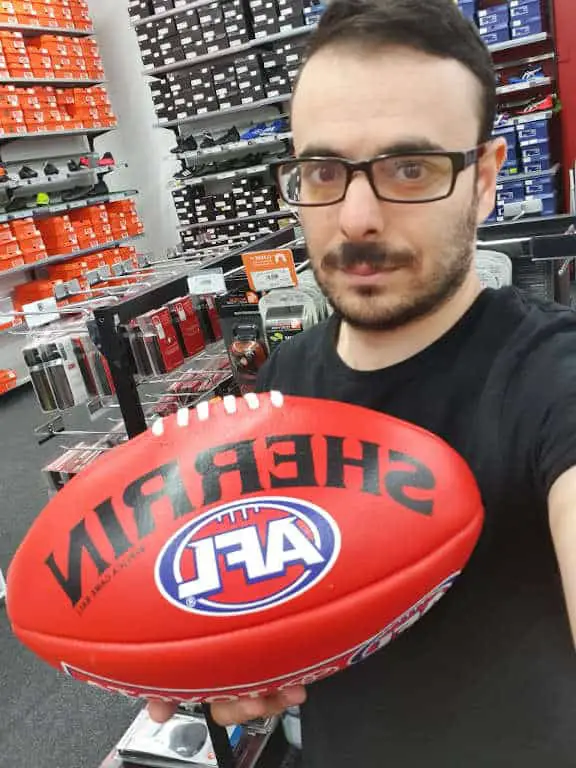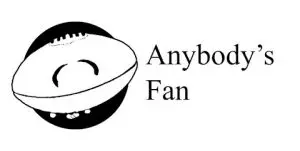I found my old “footy” box recently when moving house. Buried amongst the gear was my old football that I used to train with and kick around in the backyard. It got me thinking about what it’s like today: What are the costs, brands, and even sizes of football that are used today.
I did some research and found out these details for the different footballs used in AFL:
- Typical costs for each brand of football
- Brand details, such as where you can expect to see them used
- Size comparison of the different football sizes
- Colours you can find footballs in
- Life span of a football: How long you can expect a football to last (matches, training, and when it lives in the back yard)
In summary, a football can cost between $30 and $160; there are three brands used in competition (the official being Sherrin); Size 5 is the official AFL size and Size 4 is the official AFLW size; red and yellow are the official colours (though others are available); and a football is used for a single match or many years of training (can last over a decade!).

Football Costs Compared
An AFL football typically costs between $40 and $160. The more expensive balls are made from different types of leather, and are typically used in professional competitions.
| Football | Typical Price |
|---|---|
| Sherrin Kangaroo Brand | $160 |
| Sherrin Lyrebird | $60 |
| Ross Fulkner (Australian Made) | $70 – $80 |
| Ross Faulkner (imported) | $40 |
| Burley Match | $40 |
| Burley Rover | $30 |
All prices come from the manufacturer or retail stores. Prices might vary based on discounts, mark-ups, shipping, and related items before the ball gets in your hands. Check out my References section at the end of this guide for more details.
My list above includes footballs looking to conform with AFL guidelines for size and weight.
I used to play with the Lyrebird when I was growing up. It was a lot cheaper than the other Sherrin’s because it’s made of cheaper imported leather. I’ve found these Lyrebird balls popular for local clubs looking to buy a large number of balls for training. I also found they’re slightly smaller and with pointier ends, making it easier for kicking and marking.
Football Brands
Each of the footy states has preferences for the brands of football they use. The different brands of football are:
- Sherrin, the “Kangaroo Brand”, the official brand of the VFL and AFL;
- Ross Faulkner, used by the local competitions where I live in Victoria;
- Burley Sekem, preferred in Western Australia and South Australia.
Burley Sekem also provide all the apparel as well as footballs for the WANFL and the SANFL, including the women’s competition in these states.
Sherrin started making footballs in 1880 specifically designed for Aussie rules. When the first clubs broke away to form the VFL (now the AFL), Sherrin was retained as the ball of choice having been mass produced in their Collingwood factory.
There are of course other no-name brands of football. I find these don’t have the right weight or feel of a good quality brand however. If you want to buy a football that will last years, or you want the weight and feel of an official ball, I reckon you should stick to these brands.
Football Sizes
Each of the brands manufactures their balls according to a common set of sizing:
| Football Size | Typical Dimensions | Use |
|---|---|---|
| Size 5 | Long: 72.5cm Short: 55cm | Official AFL ball size |
| Size 4.5 | Long: 70cm Short: 52cm | Former AFLW ball size, now used in local leagues |
| Size 4 | Long: 69cm Short: 53cm | Official AFLW ball size |
| Size 3 | Long: 65cm Short: 49cm | Children size (usually ages 6-10) |
Long and Short refer to the circumference of the long dimension of the ball and the short dimension of the ball respectively.
Size 5, aka the Kangaroo Brand, is the official size of the AFL competition. It’s also used for men’s competitions over the age of 15. Despite the name, I assure you it’s not made of Australia’s favourite marsupial (it’s made from cow hide).
Size 4.5 is a new size targetted at the women’s competition. It’s no longer used for AFLW but is still used in some local leagues.
Size 4 is the official AFLW size. I’ve found it’s also a good size for teenage players as they out-grow the smaller sizes below. When used officially it’s made out of leather, but can also be made out of softer rubber synthetic when used for kids games.
Size 3 are used for younger kids starting out in the game (usually 6-10 years old). It’s also usually made from the softer rubber synthetic.
Size 2 and Size 1 are usually for kids that aren’t quite big enough yet to handle a size 3.
Football Colours
There are two official match football colours in use:
- Red, used for day time matches
- Yellow, used for twilight and night matches
I’ve played with other colours over the years, such as half-red half-yellow, orange, pink, and white. These were mostly used in training. There are also fun variety colours and patterns such as club colours.
The yellow colour seems to be preferred by players and umpires, due to the visibility. There doesn’t seem to be any difference between red and yellow apart from the colour. This comes from a study I read once (dug up the article here).
How long footballs last
Based on my experience, here’s how long I reckon a good footy (one of the brands above) should last:
For matches, we’d use a new football for every match. I assume the AFL, AFLW, VFL, and other professional competitions are all the same. From memory, these balls then became training balls (so at least they weren’t going to waste after each match).
For training, the footballs we used would last for years. I remember even at the start of the training season, the balls would be scuffed and worn. We used a lot of balls for training, so it was always important for the club to get good value out of its purchase. With regular training, I reckon we got 2 seasons out of each ball.
For fun, for a ball to kick around in the backyard, I’ve had mine for well over a decade. I usually give it a kick around with mates, so we’re not exactly wearing out the ball much. My favourite’s lasted me over 10 years and I expect it to last longer still.
Often the end of life for a football is when the air bladder inside fails to hold the air in and the ball goes flat. Sherrin offers a service to replace the bladder insider their official sized balls. Find out more details here: https://www.sherrin.com.au/care-maintenance
Bottom Line
When I started out I would try to use the Sherrin Lyrebird. These are a good football to start with to learn the skills of the game.
The shape is friendlier when learning the basics of kicking and marking. It also gives a closer feel to the leather used in the official Kangaroo Brand Sherrin.
While I’ve heard arguments that the smaller size 3 and size 4 balls can also make it easier to learn, I feel the rubber synthetic typically used in the smaller balls isn’t comparable to the real lather. In my opinion, it’s important to get a feel for the actual hardness and texture of kicking, punching, and catching real leather.
References
I can only remember so much. Here are the websites I used in putting together this guide and fact checking my memory. Click any one for more information.
- Sherrin size guide
- Retail prices for footballs
- Official Sherrin prices
- Ross Faulkner prices and colours
- Burley Sekem prices and colours
Cass was born holding a football in his arms. Since then he’s been inseparable from the game. When he’s not kicking a ball around the backyard, he’s out there cheering on the Roos. Cass also hosts a podcast called Anybody’s Game. Check it out here: angrylittlemanproductions.com/anybody-s-game
